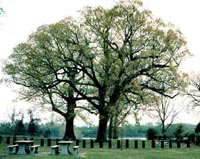Resource Library
Plant of the Week: White Oak
The University of Arkansas System Division of Agriculture does not promote, support or recommend plants featured in "Plant of the Week." Please consult your local Extension office for plants suitable for your region.
Plant of the Week
White Oak
Latin: Quercus alba

There are 450 kinds of oaks in the world, about 85 in North America and about 40 in Arkansas, but all of these pale when compared to the grandfather of the tribe, the white oak.
The white oak is not common in the nursery trade because it is slow growing, by nursery standards. It is this very characteristic that makes it special in our gardens and forests.
White oaks live for centuries. The Wye Mill Plantation in Maryland, site of the recently signed peace accords, has a beautiful 350-year-old specimen. Our own state has the 300-year-old Council Oaks. These are the white oaks in Dardanelle under which Robert Crittenden signed the 1823 treaty ceding the land south of the Arkansas River to white settlement. Because of their potential for attaining such great age, white oaks should always get first consideration when it comes to our protection.
The oak clan is divided into two tribes, the white oaks and the red oaks. The red oaks, regardless of the shape of the leaf, always have a bristle on the tip of the leaf while the white oaks have rounded lobes and never have a bristle. The acorns of white oaks also germinate differently, with a root emerging in the fall when they drop. The shoot does not appear until the following spring. Red oaks send down their tap root in the spring when the top starts growing.
To foresters, the major difference is in the characteristics of the wood. White oak wood has no passageways through the wood in the heartwood, where red oaks do have passages in the vessels.
Because of this, white oaks can be used to make whiskey barrels, while red oaks make better railroad ties because they will absorb the creosote being applied under pressure. The heartwood of white oaks does not allow cross movement of air and moisture, making them less likely to decay internally. That’s why they have the potential to attain great age. Most of our hardwood oak floors are made from red oak because the wood is a bit harder and has golden to brown markings. White oak wood is often used in furniture frame construction and is more or less white in color.
The growth rate of white oaks is reasonable as far as shade trees go. I planted a 6-foot tall white oak 20 years ago that today, is 35 feet tall with a spread of 22 feet and a trunk diameter of 16 inches. Mature trees can easily reach 100 feet in height with a spread of 125 feet and limbs the size of ordinary trees. The leaves have seven to nine rounded lobes and usually are shades of yellow, or occasionally orange, in the fall. White oaks have a beautiful gray, plated bark that make the trees stand out in the woods.
In the garden, white oaks are neighborly. While they are big trees, they are not shallow rooted. This makes it possible to grow other plants under their limbs without having to leave a garden hose dripping on the plant like you do with maples.
White oaks have a couple of insects that occasionally produce unusual galls on the leaves, but this simply adds to their beauty and interest in the landscape. The only serious pest to the white oak is man. Because they live so long and get so big, they are perceived to be standing in the way of progress, so they must be removed. Or the timberman calculates the number of railroad ties that can be cut and reaps the short term cash flow benefits and harvests a tree capable of growing centuries old.
By: Gerald Klingaman, retired
Extension Horticulturist - Ornamentals
Extension News - November 20, 1998
The University of Arkansas System Division of Agriculture does not maintain lists of retail outlets where these plants can be purchased. Please check your local nursery or other retail outlets to ask about the availability of these plants for your growing area.